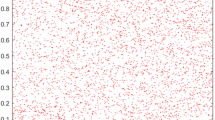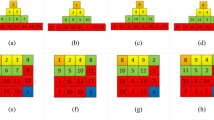Abstract
Almost all existing image encryption algorithms are only suitable for low-resolution images in the standard image library. When they are used to encrypt high-resolution images, they will inevitably suffer from inefficiency or program crashes. Inspired by the super-pixel concept in image processing, in this paper, a new image encryption algorithm using PRSP (Pseudo Random Super Pixel) strategy and KBCA (Key-based Cellular Automata) is proposed. Both scrambling and diffusion are implemented in parallel to improve the efficiency of encryption algorithm when encrypting ultra-high resolution images. Besides, random diffusion path is designed to ensure the security of encryption algorithm. Simulations are carried out using CUDA (Compute Unified Device Architecture) platform, and simulation results show the high efficiency and security of our algorithm.












Similar content being viewed by others
References
Alvarez G, Li S (2006) Some basic cryptographic requirements for chaos-based cryptosystems. Int J Bifurcat Chaos 16(8):2129–2151. https://doi.org/10.1142/S0218127406015970
Castro J-C-H, Sierra J-M, Seznec A, Izquierdo A, Ribagorda A (2005) The strict avalanche criterion randomness test. Math Comput Simul 68 (1):1–7. https://doi.org/10.1016/j.matcom.2004.09.001
Cavusoglu U, Kacar S (2019) A novel parallel image encryption algorithm based on chaos. Clust Comput 22:1211–1223. https://doi.org/10.1007/s10586-018-02895-w
Cao W, Mao Y, Zhou Y (2020) Designing a 2D infinite collapse map for image encryption. Signal Process 171:107457. https://doi.org/10.1016/j.sigpro.2020.107457
Chai X, Fu X, Gan Z, Lu Y, Chen Y (2019) A color image cryptosystem based on dynamic DNA encryption and chaos. Signal Process 155:44–62. https://doi.org/10.1016/j.sigpro.2018.09.029
Enayatifar R, Guimaraes F-G, Siarry P (2019) Index-based permutation-diffusion in multiple-image encryption using DNA sequence. Opt Lasers Eng 115:131–140. https://doi.org/10.1016/j.optlaseng.2018.11.017
Enayatifar R, Abdullah A-H, Isnin I-F (2014) Chaos-based image encryption using a hybrid genetic algorithm and a DNA sequence. Opt Lasers Eng 56:83–93. https://doi.org/10.1016/j.optlaseng.2013.12.003
Fridrich J (1998) Symmetric ciphers based on two-dimensional chaotic maps. Int J Bifurcat Chaos 08(06):1259–1284. https://doi.org/10.1142/S021812749800098X
Gao W, Sun J, Qiao W, Zhang X (2019) Digital image encryption scheme based on generalized Mandelbrot-Julia set. Optik 185:917–929. https://doi.org/10.1016/j.ijleo.2019.02.007
Ghadirli H-M, Nodehi A, Enayatifar R (2019) An overview of encryption algorithms in color images. Signal Process 164:163–185. https://doi.org/10.1016/j.sigpro.2019.06.010
Hua Z, Zhou Y, Huang H (2019) Cosine-transform-based chaotic system for image encryption. Inf Sci 480:403–419. https://doi.org/10.1016/j.ins.2018.12.048
Hayat U, Azam N-A (2019) A novel image encryption scheme based on an elliptic curve. Signal Process 155:391–402. https://doi.org/10.1016/j.sigpro.2018.10.011
Han Y, Zhang Y (2010) Optical image encryption based on two beams’ interference. Opt Commun 283:1690–1692. https://doi.org/10.1016/j.optcom.2009.12.060
Jithin KC, Sankar S (2020) Colour image encryption algorithm combining Arnold map, DNA sequence operation, and a Mandelbrot set. J Inform Secur Appl 50:102428. https://doi.org/10.1016/j.jisa.2019.102428
Kumar R, Bhaduri B (2017) Optical image encryption using Kronecker product and hybrid phase masks. Opt Laser Technol 95:51–55. https://doi.org/10.1016/j.optlastec.2017.03.041
Luo Y, Zhou R, Liu J, Cao Y, Ding X (2018) A parallel image encryption algorithm based on the piecewise linear chaotic map and hyper-chaotic map. Nonlinear Dyn 93:1165–1181. https://doi.org/10.1007/s11071-018-4251-9
Liu H, Wang X (2011) Color image encryption using spatial bit-level permutation and high-dimension chaotic system. Opt Commun 284:3895–3903. https://doi.org/10.1016/j.optcom.2011.04.001
Li C, Luo G, Li C (2018) A parallel image encryption algorithm based on chaotic Duffing oscillators. Multimed Tools Appl 77:19193–19208. https://doi.org/10.1007/s11042-017-5391-5
Liu M-Y, Tuzel O, Ramalingam S, Chellappa R (2011) Entropy rate superpixel segmentation. In: IEEE Conference on Computer Vision and Pattern Recognition, pp 2097–2104. https://doi.org/10.1109/CVPR.2011.5995323
Lee W -K, C.-W.Phan R, Yap W-S, Goi B-M (2018) SPRING: A novel parallel chaos-based image encryption scheme. Nonlinear Dyn 92:575–593. https://doi.org/10.1007/s11071-018-4076-6
Li Z, Chen J (2015) Superpixel segmentation using linear spectral clustering. In: IEEE Conference on Computer Vision and Pattern Recognition, pp 1356–1363. https://doi.org/10.1109/CVPR.2015.7298741
Leng L, Zhang J, Khan M-K, Chen X, Alghathbar K (2010) Dynamic weighted discrimination power analysis: Anovel approach for face and palmprint recognition in DCT domain. Int J Phys Sci 5(17):2543–2554. https://doi.org/10.5897/IJPS.9000180
Leng L, Li M, Kim C, Bi X (2017) Dual-source discrimination power analysis for multi-instance contactless palmprint recognition. Multimed Tools Appl 76:333–354. https://doi.org/10.1007/s11042-015-3058-7
Mondal B, Singh S, Kumar P (2019) A secure image encryption scheme based on cellular automata and chaotic skew tent map. J Inform Secur Appl 45:117–130. https://doi.org/10.1016/j.jisa.2019.01.010
Mahmud M, Atta-ur-Rahman Lee M, Choi J -Y (2020) Evolutionary-based image encryption using RNA codons truth table. Opt Laser Technol 121:105818. https://doi.org/10.1016/j.optlastec.2019.105818
Norouzi B, Mirzakuchaki S (2014) A fast color image encryption algorithm based on hyper-chaotic systems. Nonlinear Dyn 78:995–1015. https://doi.org/10.1007/s11071-014-1492-0
Niyat A-Y, Moattar M-H, Torshiz M-N (2017) Color image encryption based on hybrid hyper-chaotic system and cellular automata. Opt Lasers Eng 90:225–237. https://doi.org/10.1016/j.optlaseng.2016.10.019
Ping P, Wu J, Mao Y, Xu F, Fan J (2018) Design of image cipher using life-like cellular automata and chaotic map. Signal Process 150:233–247. https://doi.org/10.1016/j.sigpro.2018.04.018
Patro KA-K, Raghuvanshi A-S, Acharya B (2019) A parallel bit-plane operation based chaotic image encryption scheme. Proceedings of the Third International Conference on Microelectronics. Computing and Communication Systems 556:143–154. https://doi.org/10.1007/978-981-13-7091-5_13
Ren X, Malik J (2003) Learning a classification model for segmentation. ICCV 1:10–17. https://doi.org/10.1109/ICCV.2003.1238308
Shannon CE (1949) Communication theory of secrecy system. Bell Syst Tech J 28:656–715. https://doi.org/10.1002/j.1538-7305.1949.tb00928.x
Tian Z, Lin Y (2016) Video object segmentation based on supervoxel for multimedia corpus construction. Neurocomputing 215:128–137. https://doi.org/10.1016/j.neucom.2015.06.114
Van den Bergh M, Boix X, Roig G, de Capitani B, Van Gool L (2012) SEEDS: Superpixels Extracted via energy-driven sampling. European Conference on Computer Vision 7578:13–26. https://doi.org/10.1007/s11263-014-0744-2
Vaish A, Kumar M (2017) Color image encryption using MSVD, DWT and Arnold transform in fractional Fourier domain. Optik 145:273–283. https://doi.org/10.1016/j.ijleo.2017.07.041
Wang M, Wang X, Zhang Y, Gao Z (2018) A novel chaotic encryption scheme based on image segmentation and multiple diffusion models. Opt Laser Technol 108:558–573. https://doi.org/10.1016/j.optlastec.2018.07.052
Wang X, Feng L, Zhao H (2019) Fast image encryption algorithm based on parallel computing system. Inf Sci 486:340–358. https://doi.org/10.1016/j.ins.2019.02.049
Wang H, Xiao D, Li M, Xiang Y, Li X (2019) A visually secure image encryption scheme based on parallel compressive sensing. Signal Process 155:218–232. https://doi.org/10.1016/j.sigpro.2018.10.001
Wang X, Wu C, Xiang K, Chen W (2017) Efficient local and global contour detection based on superpixels. J Vis Commun Image Represent 48:77–87. https://doi.org/10.1016/j.jvcir.2017.06.005
Wang H, Xiao D, Chen X, Huang H (2018) Cryptanalysis and enhancements of image encryption using combination of the 1D chaotic map. Signal Process 144:444–452. https://doi.org/10.1016/j.sigpro.2017.11.005
Wang S, Wang C, Xu C (2019) An image encryption algorithm based on a hidden attractor chaos system and the Knuth–Durstenfeld algorithm. Opt Lasers Eng 128:105995. https://doi.org/10.1016/j.optlaseng.2019.105995
Wang X, Zhang H, Bao X -M (2016) Color image encryption scheme using CML and DNA sequence operations. BioSystems 144:18–26. https://doi.org/10.1016/j.biosystems.2016.03.011
Wolfram S (1984) Cellular automata as models of complexity. Nature 311:419–424. https://doi.org/10.1038/311419a0. https://ui.adsabs.harvard.edu/link_gateway/1984Natur.311..419W/
Wolfram S (1986) Random sequence generation by cellular automata. Adv Appl Math 7:123–169. https://doi.org/10.1016/0196-8858(86)90028-X
Wu Y, Zhou Y, Saveriades G, Agaian S (2013) P.noonan J, Natarajan P Local Shannon entropy measure with statistical tests for image randomness. Inf. Sci 222:323–324. https://doi.org/10.1016/j.ins.2012.07.049
Wu Y (2011) NPCR And UACI randomness tests for image encryption. Cyber J Multidisci J Sci Technol J Select Areas Telecommun (JSAT): 31–38
Wu J, Liao X, Bo Y (2018) Image encryption using 2D hénon-sine map and DNA approach. Signal Process 153:11–23. https://doi.org/10.1016/j.sigpro.2018.06.008
Wu X, Wang D, Kurths J, Kan H (2016) A novel lossless color image encryption scheme using 2D DWT and 6D hyperchaotic system. Inform Sci 349–350:137–153. https://doi.org/10.1016/j.ins.2016.02.041
Xu M, Tian Z (2019) A novel image cipher based on 3D bit matrix and latin cubes. Inf Sci 478:1–14. https://doi.org/10.1016/j.ins.2018.11.010
Zhang W, Zhu Z, Yu H (2019) A Symmetric image encryption algorithm based on a Coupled Logistic-Bernoulli map and cellular automata diffusion strategy. Entropy 21:504. https://doi.org/10.3390/e21050504
Zhang W, Yu H, Zhao Y-L, Zhu Z-L (2016) Image encryption based on three-dimensional bit matrix permutation. Signal Process 118:36–50. https://doi.org/10.1016/j.sigpro.2015.06.008
Zhang Y (2020) The fast image encryption algorithm based on lifting scheme and chaos. Inf Sci 520:177–194. https://doi.org/10.1016/j.ins.2020.02.012
Acknowledgments
This research was supported by the National Natural Science Foundation of China(Grant Nos. 61977014, 61902056, 61603082), the Fundamental Research Funds for the Central Universitie (Grant Nos. N2017011, N2017016).
Author information
Authors and Affiliations
Corresponding author
Ethics declarations
Conflict of Interests
The authors declare that they have no conflict of interest.
Additional information
Publisher’s note
Springer Nature remains neutral with regard to jurisdictional claims in published maps and institutional affiliations.
Rights and permissions
About this article
Cite this article
Zhang, W., Han, W., Zhu, Z. et al. An ultrahigh-resolution image encryption algorithm using random super-pixel strategy. Multimed Tools Appl 80, 33429–33454 (2021). https://doi.org/10.1007/s11042-021-11096-4
Received:
Revised:
Accepted:
Published:
Issue Date:
DOI: https://doi.org/10.1007/s11042-021-11096-4




